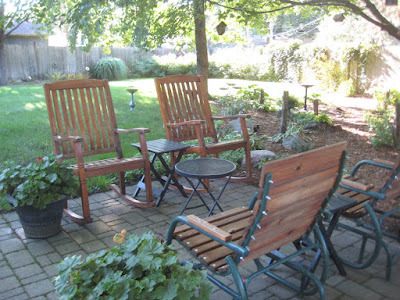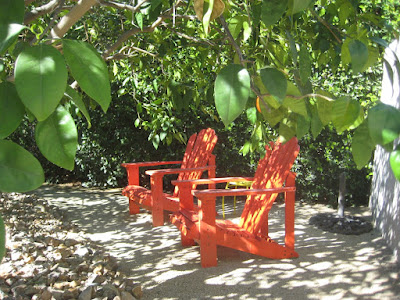Brian and Amy are teaching
their three kids about financial literacy. So are Melanie and Scott. The Colorado
kids have all received books on finance and money management. It’s a great
introduction to the wonderful world of cash, credit cards and debit. In
Minnesota, Brennan and Charlotte already have part-time jobs in the
neighborhood and are learning common sense financial lessons. These are money
management truisms that a lot of adults could/should probably revisit
themselves.
One of the best books I’ve read
on money management was written by a rabbi out of Washington, D.C. He talked
about our own personal relationship with money and how it can affect us all
from early childhood on until the end.
He states: “Real wealth, in
financial terms, is having enough and being content. Going beyond the financial
realm, real wealth means living a life in sync with your personal values. This
results in a sense of “wellth,” which is the real reward we can have in our
life.
Spending time in a resort town
like Palm Springs can be an exercise in excess, over-indulgence and material
worship. It’s California, so, of course, real estate often plays an elevated
role in one’s personal finances. Yet here, like everywhere else on the plant,
folks can have some very strange ideas about real estate.
Some of the more naïve comments
go like this:
“This is what
I want for my property because it’s worth it.”
“If it goes up in value, I’m a genius, if it goes down,
it’s the marketplace.”
“Real estate always goes up in value (not around 2008).”
“They aren’t making any more land.”
“If you own property, you must be rich” (forgetting about mortgage
payments, maintenance costs, taxes, insurance, utilities, etc.)
I
think my kids are on the right track teaching their children about financial
literacy. Since before the dawn of time (or at least it seems that way)
financial advisors have been telling us how to save for our retirement. For a
long time, they claimed there was some kind of magic formula and if you were
lucky enough to reach that equation, you’d be ‘set for life’. They, of course,
knew the secret route on that successful journey toward retirement bliss and
happiness.
At
last count, it had reached a zenith of one million, two hundred and fifty
thousand dollars. Once there, you were assured (according to them) of a
comfortable retirement…without ever really defining what that is supposed to
look like.
A
while back, I was jaw-boning about this approach to planning for retirement
with a retired school administrator. He’s written a book about safe, sane investing
aimed at the educational community. As a past educator, he knows that many of
his fellow teachers are not as financially savvy as they should be. We talked
about our own divergent pathways to retirement and he mentioned a new movement
that he’s become intrigued with now.
It’s
called FIRE and it purports to have found a new route to financial freedom for
the younger generations. My friend tells me that millennials in particular seem
to have gravitated toward this new ‘routine in financial living. FIRE is an
acronym for ‘Financial Independence, Retire Early.’ To better understand the
concept, I’ve borrowed some of the high points of this philosophy from the Investopedia web site.
The
web site explains that: ‘Financial
Independence, Retire Early (FIRE) is a movement of people devoted to a program
of extreme savings and investment that aims to allow them to retire far earlier than traditional
budgets and retirement plans would permit.
Born out of the 1992 best-selling book Your
Money or Your Life by Vicki Robin and Joe Dominguez, FIRE came to embody a
core premise of the book: People should evaluate every expense in terms of
the number of working hours that it took to pay for it.
Key Takeaways of FIRE
- Financial Independence, Retire
Early (FIRE) is a financial movement defined by frugality and extreme
savings and investment.
- By saving up to 70% of their
annual income, FIRE proponents aim to retire early and live off small
withdrawals from their accumulated funds.
- Typically, FIRE followers withdraw
3% to 4% of their savings annually to cover living expenses in retirement.
- Detailed planning, economic
discipline, and wise investment are key components in achieving a FIRE
retirement.
- The FIRE movement was inspired by
the 1992 book Your Money or Your Life, written by two financial
gurus.
The FIRE movement
takes direct aim at the conventional retirement age of 65 and the industry that
has grown up to encourage people to plan for it. By dedicating a majority of
their income to savings, followers of the FIRE movement hope to be able to quit
their jobs and live solely off small withdrawals from their portfolios decades before they reach age 65.
To cover their living expenses after
retiring at a young age, FIRE devotees make small withdrawals from their
savings, typically around 3% to 4% of the balance yearly. Depending on the size of their
savings and their desired lifestyle, this requires extreme diligence to monitor
expenses as well as dedication to the maintenance and reallocation of
their investments. Several FIRE
retirement variations that dictate the lifestyle that the FIRE movement’s
devotees are willing and able to maintain have evolved within it, as reported by Forbes
Advisor.
- Fat FIRE—This is for the individual with a
traditional lifestyle who aims to save substantially more than the
average worker but doesn’t want to reduce their current standard of
living. It generally takes a high salary and aggressive savings and investment
strategies for it to work.
- Lean FIRE—This requires stringent adherence
to minimalist living and extreme savings, necessitating a far more
restricted lifestyle. Many Lean FIRE adherents live on $25,000 or less per
year.
- Barista FIRE—This is for people who want to
exist between the two choices above. They quit their traditional 9-to-5
jobs but use a combination of part-time work and savings to live a
less-than-minimalist lifestyle. The former lets them obtain health
coverage, while the latter prevents them from dipping into their retirement
funds.
Most people think that FIRE is meant
for people who can pull in a substantial income, generally in the six figures.
And indeed, if your goal is to retire in your 30s or 40s, that probably is the
case. However, there is plenty for everyone to learn from the principles of the
movement that can help people save for their own retirement and even achieve an
early one, if not quite as early as 40.’
Sprinkled throughout the web site are
some interesting points about good old simple planning ahead for retirement.
For many young folks, that’s easier said than done. One pundit commented that
the best time to save is when you’re first starting out in a new job or getting
married and settling into a new lifestyle. Of course, he failed to mention that
that period is when we generally incur a lot more expenses than earlier in
life. If you are married, have kids, a house payment and other household
expenses then saving for retirement usually isn’t high on your radar scope.
The FIRE movement has many solid,
common-sense arguments in its favor. While I have little desire to poke holes
in their concept, I do find one equation that is either ignored or just passed
over briefly; that is, living the life you want to live. Postponing life
events, small pleasures and everyday occurrences just to save a buck doesn’t
seem to me a good way to spend one’s life.
The web site argues, quite
convincingly, that: ‘no one can achieve a secure retirement without investing in their retirement savings. FIRE adherents invest larger portions
of their income than the average person will want to. But the principle of
setting aside a set percentage of your income every month for investment—and
starting to do that as early as possible—will allow you to grow your retirement
savings to a point where they can assure you financial stability in your later
years.’ It’s not exciting or adventurous but it gets the job done. Frankly,
it’s plain vanilla investing and skipping the potholes sometimes hidden in
crypto currency, investing in sports teams, Robin Hood investing and other
schemes that only PT Barnum could appreciate.

It certainly helps to be able to
recognize the difference between ‘having to have’ verses ‘wanting to have.’ Our
capitalistic society thrives on the economic engine of consumption and always
wanting more. A recent advertisement for Lincoln automobiles proclaims that:
‘Owning a Lincoln means you have arrived.’ No, it doesn’t!
It just means you’ve bought into the
American Dream of having more and feeling good about yourself. Real success
lies in ‘living a satisfying, fulfilling life’ and not having a new car in the
driveway just to impress your neighbors. Having a lot of assets is less
important than knowing you control them, not the other way around.
Strength is in knowing you could if you
wanted to but you choose not to. It means spending as much time as you can with
your kids and/or grandchildren when they’re young. It means spending quality
time with your spouse or partner in life. It means taking the time to ‘smell
the roses’ and treasure each day as a gift to be shared, enjoyed and relished
as if it were your last.
Because at some point, it will be’ that
point’…that all the money in the bank can’t make up for lost time or
opportunities to ‘live your life.’ That’s a lesson I hope my grandchildren can
grab on to early in their money-earning lives.












































